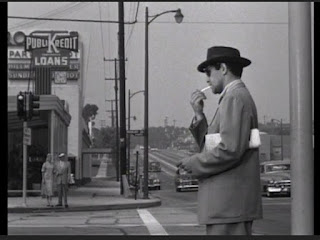There are many other things in Boetticher's work that is special, such as their depictions of deep friendships and the visual style. Some of my favourite shots of all time are to be found in his work, and nothing beats this one from Ride Lonesome (1959):
Their force come not just from the beauty of them but also from the emotional undercurrent that they express, or crystallise. The films are often tragedies, and the images express that too. Comanche Station (1960) is a film about a man who has spent the last ten years mourning the loss of his wife while still searching for her in the mad hope that she might still be out there, somewhere. The film ends like it begins, with him alone on his horse, still searching.
Earlier this year an edited collection called ReFocus: The Films of Budd Boetticher was published by Edinburgh University Press and I contributed a chapter to it. What follows is a part from the introduction to my chapter. First I raise some questions about the concept of the "classical Hollywood style" of filmmaking and wondering whether there is such a thing and how it is to be defined. My suggestion is "a linear narrative, unambiguous cause and effect, an unobtrusive visual style and unironic tone" (which obviously leaves out quite a lot of Hollywood films that use other styles of filmmaking) and then I turn to Boetticher:
Where does this leave Budd Boetticher? One the one hand his films do have a linear narrative, unambiguous cause and effect, an unobtrusive visual style and they are not obviously ironic, so in that respect it could be argued that he is a director who actually do make films in the style of authentic “classical” American cinema. But at the same time he is one of the most austere filmmakers of those who worked in Hollywood. His precise, economical style is sometimes more reminiscent of directors such as Yasujiro Ozu or Robert Bresson than any of his American contemporaries. There is rarely any stylistic excess or flamboyance, the actors underplay and are often expressionless and there is nothing that could be described as showing off. To some this might be regarded as a consequence of his films’ comparatively small budgets although there is actually no obvious correlation between a small budget and an austere style. Filmmakers like Edgar G. Ulmer, Joseph H. Lewis and Samuel Fuller made films on equally small, or even smaller budgets, than Boetticher yet their style of filming was very different from his, and much more expressionistic and flamboyant. So Boetticher’s style of filmmaking should be regarded as a conscious choice; that he prefers this straightforward and low key style, and it is after all a style that is congenial with the themes of his films. The thing that really matters in his best films is the behavior of the characters, their moral code and grace under pressure, and these characters do not talk much and do not try to show off, nor do they become overtly emotional. (Those that try to show off are usually punished.) With his recurring theme of stoicism and grace it should not come as a surprise that Boetticher had a keen interest in bullfighting, and that he made several films on the subject. The first of these is Bullfighter and the Lady (1951), a key development in Boetticher’s career, the first full-length A-film that he made, as well as his first film about bullfighting. This chapter will argue that Bullfighter and the Lady is an important film, and show how several of Boetticher’s themes and motifs, and his style of filmmaking, are fully formed here. It will also argue that there are links to both the transcendental style of filmmaking that Paul Schrader writes about, and to Taoism, the Chinese philosophical system, or way of life.While Boetticher is today remembered for his Westerns he made many other films that are also often as good and Bullfighter and the Lady is one example of that, as is the thriller The Killer is Loose (1956). Seek them out.
Seven Men from Now
The Killer is Loose
-----------------------------------
2017-08-18 I am aware that Edgar is Ulmer's first name, not Edward, so I have corrected that now, and I added a few words in the fourth paragraph.



